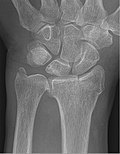Chauffeur's fracture: Difference between revisions
CSV import Tags: mobile edit mobile web edit |
CSV import |
||
| Line 19: | Line 19: | ||
[[Category:Injuries]] | [[Category:Injuries]] | ||
{{medicine-stub}} | {{medicine-stub}} | ||
<gallery> | |||
File:Chauffeur-Fraktur_und_PSU_bei_Ulnavorschub_mit_Impaktation_83W_-_CR_ap_-_001.jpg|Chauffeur's fracture | |||
File:Displaced_distal_radius_fracture.jpg|Displaced distal radius fracture | |||
</gallery> | |||
Revision as of 01:24, 18 February 2025
Chauffeur's fracture, also known as a Hutchinson fracture or backfire fracture, is a specific type of fracture of the radius bone of the forearm, typically resulting from a direct blow to the distal radius or from compressive forces transmitted through the radial styloid process. This injury is historically named after the mechanism by which early automobile chauffeurs sustained the fracture; the backfire of a hand-cranked engine would cause the crank to kick back, striking the radial styloid process and causing a fracture.
Causes and Mechanism
The Chauffeur's fracture is most commonly caused by a direct impact to the radial side of the wrist or by a fall onto an outstretched hand, with the force directed towards the radial styloid. This results in a fracture of the radial styloid process, which can vary in severity from a simple crack to a significant displacement of the bone. In modern times, this injury is more likely to occur from sports injuries, vehicular accidents, or falls, rather than the antiquated hand-cranked engines.
Symptoms and Diagnosis
Symptoms of a Chauffeur's fracture include pain, swelling, and tenderness around the wrist, particularly over the radial side. There may also be visible deformity and limited range of motion in the wrist. Diagnosis is typically confirmed through X-ray imaging, which can reveal the extent and specific location of the fracture. In some cases, advanced imaging techniques such as CT scan or MRI may be necessary to assess the injury fully.
Treatment
Treatment for a Chauffeur's fracture depends on the severity and displacement of the fracture. Non-displaced or minimally displaced fractures can often be treated conservatively with immobilization in a cast or splint for several weeks, followed by physical therapy to restore range of motion and strength. More significantly displaced fractures may require surgical intervention to realign and stabilize the bone fragments, often using pins, screws, or plates. Rehabilitation following either conservative or surgical treatment is crucial for restoring function and preventing long-term complications such as stiffness or arthritis.
Prognosis
With appropriate treatment, most individuals with a Chauffeur's fracture can expect a good recovery, regaining full or near-full function of the wrist. However, the prognosis can vary depending on factors such as the extent of the fracture, the presence of any associated injuries, and the patient's overall health and compliance with treatment and rehabilitation.
Prevention
Preventing Chauffeur's fractures involves taking general precautions to avoid falls and injuries to the wrist. This includes using protective gear during sports and other high-risk activities, ensuring safe working conditions, and promoting overall bone health through adequate nutrition and exercise.
-
Chauffeur's fracture
-
Displaced distal radius fracture


